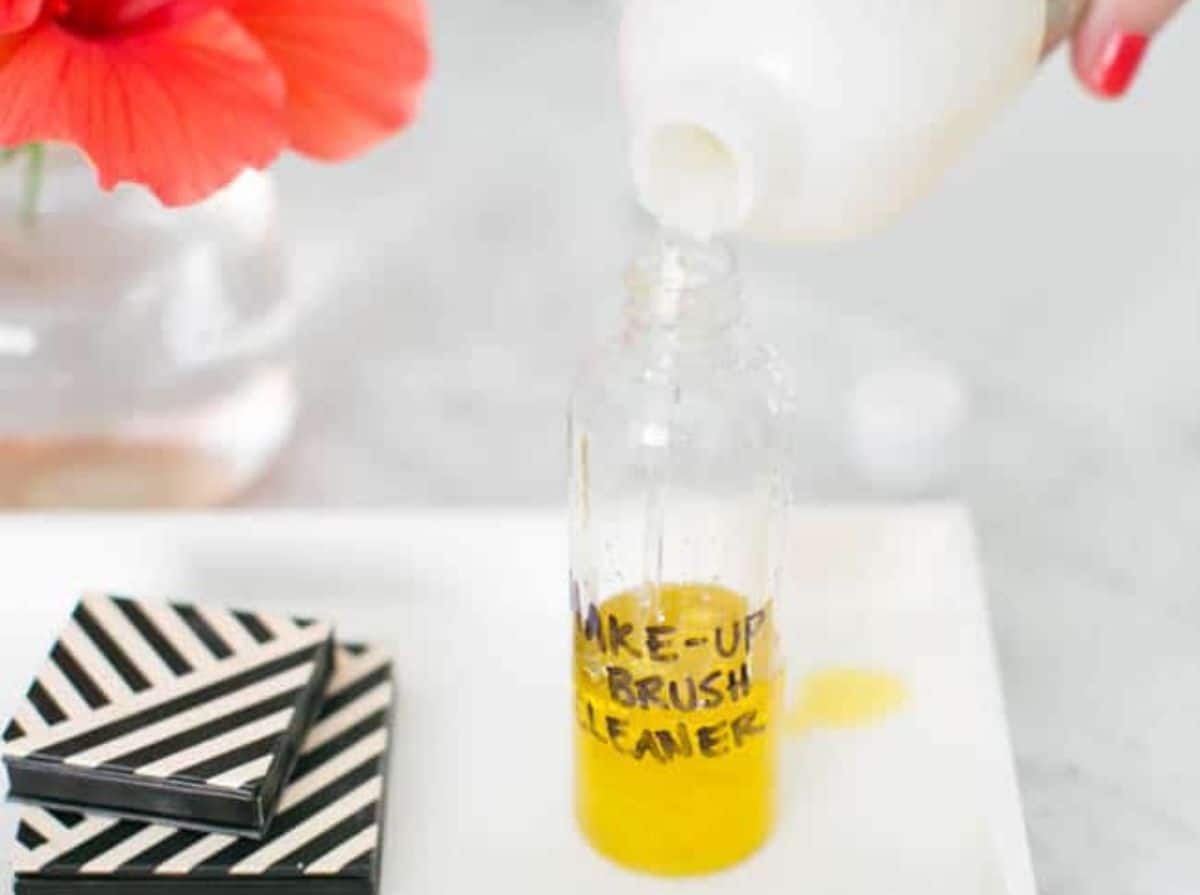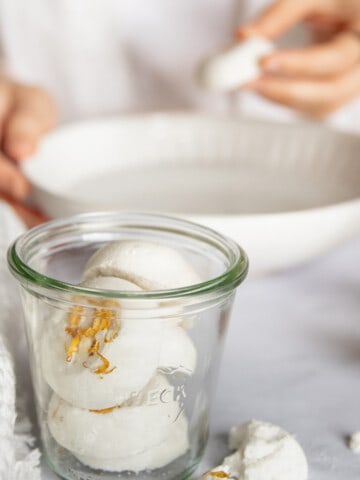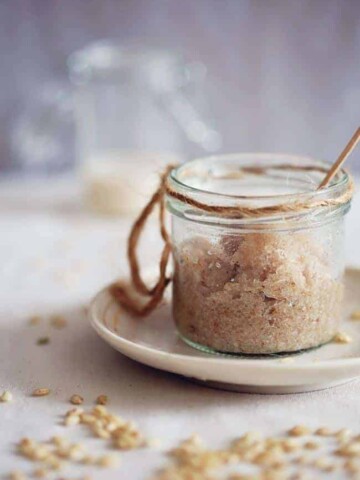Keeping makeup brushes clean affects more than just how your makeup turns out! If you have breakouts that just won’t go away, no matter what products you use— check your makeup brushes. If they’re looking a little too grimy for comfort, they’re probably long overdue for a deep clean. Learn how to clean makeup brushes with a simple 2-ingredient homemade makeup brush cleaner.

Purchasing quality makeup brushes is definitely an investment. If you don’t wear much makeup, it is hard to justify the cost, but trust me that your investment will make things easier and more rewarding when you do! So, I splurged on a makeup brush set - they’re so soft and skilled at perfectly blending out eye shadow.
And this foundation brush is the best thing ever. After learning a few tricks on how to use the brushes, it was time to figure out how to take care of them to ensure my investment would last as long as possible.
Jump to:
- Supplies
- Step 1: Mix Up Your Cleanser
- Step 2: Dip the Brush in the Cleaner and Swirl It Around
- Step 3: Use Your Hand to Clean Between the Bristles
- Step 4: Rinse the Brush
- Step 5: Clean Brush Handles
- Step 6: Lay Brushes Flat to Dry
- Step 7: Store Brushes Properly
- Other Cleaning Techniques
- How Often Should You Clean Your Brushes?
- How to Know When to Replace Makeup Brushes
- FAQ
Supplies

You don't need much to clean your makeup brushes at home. A gentle soap helps to break down greasy grime and a little bit of oil acts like a conditioner, keeping the bristles soft and flexible. Everything else is just nice to have and can help make the process easier.
- Castile soap: I use Castile soap because it's non-toxic and breaks down oily residue like a dream.
- Olive oil: Because most makeup brushes are made with natural bristles (read: hair), they can break down or fray if they get too dry. Oil acts like a conditioner, helping to keep the bristles hydrated and soft. It also helps to further break down oily residue on the bristles (just like oil cleansing your face does), resulting in cleaner brushes.
- A small bottle: If you plan to clean your brushes regularly, it helps if you whip up a large batch of cleaning solution ahead of time. A small 4-ounce squirt bottle makes for easy application.
- Small bowl: Ideal for coating the tip of the brush in cleaning solution and swirling it around to remove the gunky buildup.
- Paper towels or a wash cloth: To keep the bristles in place, it's best to lay your freshly-cleaned brushes on a paper towel or wash cloth as they dry.
Step 1: Mix Up Your Cleanser

Save yourself a few bucks and mix up your own DIY makeup brush cleaner. For the bottle above, I filled ⅓ of the container with olive oil and the rest with Castile soap.
So combine 1 oz olive oil + 3 oz Castile soap in a 4 oz bottle and voila!
It's a simple recipe, and you can keep the mixture on the bathroom counter. I'm much more likely to clean my brushes if I don't have have to round up ingredients every time.
Any brand or scent of Castile soap will work for this. Olive oil is great because it's heavy and rich, so it does a great job at melting dirt and grime on your brushes, but you could also use grapeseed or sweet almond.
Don't want to make homemade brush cleaner? No problem, you can use gentle dish soap, plain Castile soap, face cleanser, shampoo, even gentle body wash to get your brushes clean.
Step 2: Dip the Brush in the Cleaner and Swirl It Around

Pour some of the makeup cleaner in a small dish. Dip the brush into the mixture and gently swirl.
See how it's already getting cloudy with makeup coming off? That's a good sign! Keep swirling for 10-15 seconds.
Step 3: Use Your Hand to Clean Between the Bristles

Using the palm of your hand, swish the brush back and forth. Get some good suds going!
If needed, rinse off the brush (bristles pointed down), put a little bit of fresh brush cleaning solution in the palm of your hand and swirl some more. This will show you whether or not it's completely clean.
Step 4: Rinse the Brush

Rinse the brush with warm water until the water runs clean (always keep the bristles pointing downward to prevent water from getting inside the handle)
Don’t use hot water: The higher temperature of hot water could melt the glue that holds the bristles in place - completely wrecking your brush! Lukewarm or colder water is perfectly fine for cleansing brushes.
Don’t completely submerge your brushes: When you completely submerge brushes in water, you might be letting water into the brush itself. This also weakens the glue that holds your brush together, making it more prone to falling apart.
Repeat steps 2 and 3 if needed. Squeeze out an excess water.
Step 5: Clean Brush Handles
Don’t forget about your makeup brush handles, either. For cleaning makeup smudges on handles, a few go-overs with a wet wipe or makeup remover wipe usually does the trick to get the grime off!
Step 6: Lay Brushes Flat to Dry

Lay the brushes flat to dry: Lay them flat on a dry towel, or make a DIY makeup brush hanger
Some say to hang them upside down—you can easily DIY a makeup brush hanger with a clothes hanger and some hair ties.
Just don't stand them upright—the water gets into the handle and can damage the glue that holds everything together. Then the bristles might come off your brush completely - not something we want at all!
Step 7: Store Brushes Properly

Once dry, store the brushes upright in a dedicated holder or container away from your makeup. By ensuring that the bristles are not touching any surfaces, it minimizes dust and dirt accumulation and helps them last longer.
When you clean your brushes, you’re basically doing basic maintenance on them - like you would for your car. By keeping them clean and preventing the buildup of makeup and oil on the bristles, you can actually prolong the life of your brushes!
Other Cleaning Techniques
Use a Cleansing Mat: A final tip that I have to speed up the whole process is to use a brush cleansing mat - no, you don’t need a specific one from a fancy brand, either! My favorite thing to use as a cleansing mat is a silicone pot holder - they’re super cheap and do the job just as well.
Makeup Brush Cleaning Machine: If you don't have time to wash your brushes regularly, then you may want to invest in a makeup brush sanitizer.While you still need to wash your brushes occasionally in order to get rid of grease and grime, this little machine uses blue light to kill the bacteria that causes acne and breakouts. Or you can use a 2-in-1 cleaning and drying machine to put your weekly brush cleaning routine on autopilot.
How Often Should You Clean Your Brushes?
Deep cleansing brushes every week is a good rule of thumb for both makeup brushes and makeup sponges—yep, those babies aren't exempt from the weekly clean!
Brushes can become the perfect breeding grounds for bacteria—and that same bacteria can be the cause of acne if you’re not washing your brushes often enough! That means that even if your face is clean, you're just spreading the bacteria from your brushes right back to your face.
Eyes are really susceptible to getting eye infections from dirty brushes, or even a dirty mascara wand (BTW, did you know that you need to replace your mascara every 3 months as it is the perfect breeding ground for bacteria?)
You can clean daily (or after every use) if you want—that’s probably ideal. But I’m shooting for weekly.
How to Know When to Replace Makeup Brushes
After a while, you may notice that your brushes no longer perform as well as they used to and no amount of cleaning can fix it. Here are some signs to help you determine when it's time to replace a makeup brush:
- Bristle Condition. Over time, the texture of brush bristles may change. If they become rough, scratchy, or overly stiff, it can be uncomfortable and potentially irritating to your skin. Or if the bristles are frayed, split, or bent out of shape, it's a clear indication that the brush is no longer in optimal condition. Frayed bristles can affect the application of makeup and result in uneven or patchy coverage.
- Shedding. If your brush consistently sheds bristles during use, it's a sign that the brush is reaching the end of its lifespan. Not only can shedding bristles be frustrating but they can also negatively impact your makeup application.
- Loss of Performance. If you notice that a brush is no longer performing as well as it used to—such as not picking up or depositing product evenly—it's probably time to replace it.
- Difficult to Clean. If a brush becomes increasingly difficult to clean, it might be a sign that makeup residue has built up in the bristles. This can affect the hygiene of the brush and potentially lead to skin issues or breakouts.
- Odor. An unpleasant odor coming from your brush, even after cleaning, could indicate that bacteria or product residue has accumulated within the bristles or handle. This can compromise the hygiene of the brush, lead to acne or irritation, and affect how your makeup looks after application.
FAQ
Olive oil is great because it's heavy and rich, so it does a great job at melting dirt and grime on your brushes. If you don't have any, any other oil should work, but you might try sweet almond or grapeseed oil.
Fancy homemade brush cleaner isn't an absolute necessity. You can use gentle dish soap, plain Castile soap, face cleanser, shampoo, even gentle body wash to get your brushes clean.
Yes! I love baby shampoo for cleaning my brushes, but if you only have regular shampoo, go for it. Just make sure to rinse them really well.
If you're in a hurry, give your brushes a quick shot with a hairdryer. Make sure it's on the coolest, lowest setting and blow in the direction of the bristles, not against them. Doing this occasionally shouldn't harm your brushes.





